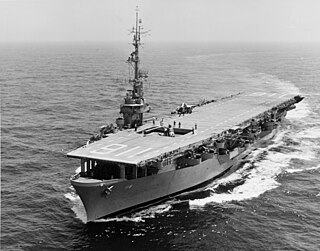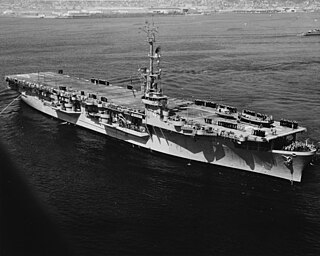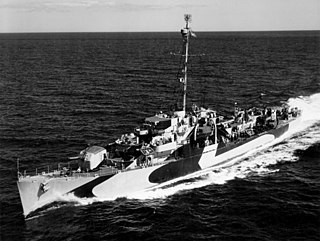
USS Badoeng Strait (CVE-116) was a Commencement Bay-class escort carrier of the United States Navy during the Korean War.

USS Arnold J. Isbell (DD-869), a Gearing-class destroyer, was the only ship of the United States Navy to be named for Arnold J. Isbell, an aircraft carrier captain during World War II. The ship was laid down on 14 March 1945 at Staten Island, New York, by Bethlehem Mariners Harbor, launched on 6 August 1945 and commissioned on 5 January 1946. Constructed too late to see action in World War II, the vessel initially served as a training ship with the United States Atlantic Fleet, before transferring to the Pacific and deploying to Korea during the Korean War and off the Vietnam coast during the Vietnam War. In 1972 Arnold J. Isbell was made part of the reserve training fleet and in 1974, sold to Greece where the ship was renamed Satchouris and served with the Hellenic Navy until being sold for scrap in 2002.

USS Bataan (CVL-29/AVT-4), originally planned as USS Buffalo (CL-99) and also classified as CV-29, was an 11,000 ton Independence-class light aircraft carrier which was commissioned in the United States Navy during World War II on 17 November 1943. Serving in the Pacific Theatre for the entire war, taking part in operations around New Guinea, the Invasion of the Mariana Islands, the Battle of the Philippine Sea, the Battle of Okinawa, and Attacks on the Japanese home islands. After World War II's end she was converted into an anti-submarine carrier and placed in reserve on 11 February 1947.

USS Volador (SS-490), a Tench-class submarine, was the second ship of the United States Navy to be named for the volador.

USS Stickell (DD-888) was a Gearing-class destroyer of the United States Navy in service from 1945 to 1972. She was renamed HS Kanaris (D212) in 1972 on transfer to the Hellenic Navy.

USS Block Island was a Commencement Bay-class escort carrier of the United States Navy. She was the second ship to carry her name, done in honor of the first one, being launched 12 days after the original was sunk.

USS Gilbert Islands (CVE-107) was a Commencement Bay-class escort carrier of the United States Navy.

USS Vermillion Bay (CVE-108) was a Commencement Bay-class escort carrier of the United States Navy. She was renamed Kula Gulf on 6 November 1943; laid down by Todd-Pacific Shipyards, Inc., Tacoma, Wash. on 16 December 1943; launched on 15 August 1944; sponsored by Miss Dorothy Mott; completed by Willamette Iron & Steel Corp., Portland, Oregon; and commissioned at Portland on 12 May 1945, Captain J. W. King in command.

USS Rendova (CVE-114) was a Commencement Bay-class escort carrier of the United States Navy.

USS Chicago (CA-136/CG-11) was a Baltimore-class heavy cruiser laid down on 28 July 1943 at Philadelphia, Pennsylvania, US, by the Philadelphia Navy Yard. Launched on 20 August 1944, she was sponsored by Mrs. Edward J. Kelly, wife of the Mayor of Chicago, Illinois, and commissioned at the Philadelphia Navy Yard on 10 January 1945, Captain Richard R. Hartung, USN, in command. It served in some of the last battles around the Japan home islands in WWII, and as part of the post war occupation fleet. Decommissioned after the war it was refitted as a missile cruiser beginning in the late 1950s and recommissioned in 1964, serving during the Vietnam War. It served until 1980. USS Chicago CG-11 carried the title of "The World's Most Powerful Guided Missile Cruiser".

USS Blackfin (SS-322), a Balao-class submarine in commission from 1944 to 1948 and from 1951 to 1972, was a ship of the United States Navy named for the blackfin cisco, a food fish of the Great Lakes.

USS Wedderburn (DD-684), was a Fletcher-class destroyer of the United States Navy.

USS Taylor (DD/DDE-468) was a Fletcher-class destroyer of the United States Navy, named for Rear Admiral William Rogers Taylor (1811–1889). She was laid down on 28 August 1941 at Bath, Maine, by the Bath Iron Works Corp.; launched on 7 June 1942, sponsored by Mrs. H. A. Baldridge; and commissioned on 28 August 1942 at the Charlestown Navy Yard near Boston, Mass.

USS Naifeh (DE-352) was a John C. Butler-class destroyer escort in service with the United States Navy from 1944 to 1960. She was sunk as a target in 1966.

USS Alfred A. Cunningham (DD-752), an Allen M. Sumner-class destroyer, is the only ship of the United States Navy to be named for Alfred Austell Cunningham, a USMC officer and aviator.

USS Bauer (DE-1025) was a Dealey-class destroyer escort in the United States Navy. She was named for Lieutenant Colonel Harold William Bauer, naval aviator and recipient of the Medal of Honor for extraordinary heroism and conspicuous courage as Commander of Marine Fighting Squadron 212 in the South Pacific between 10 May and 14 November 1942.

USS Henderson (DD-785) was a Gearing-class destroyer of the United States Navy, the second Navy ship of that name, and the first named for United States Marine Corps Major Lofton R. Henderson. The previous Henderson was named for Marine Corps Commandant Archibald Henderson.

USS Bausell (DD-845) was a Gearing-class destroyer in the United States Navy during the Korean War and the Vietnam War. She was named for Marine Corporal Lewis K. Bausell (1924–1944), who was awarded the Medal of Honor posthumously for "conspicuous gallantry" during the Battle of Peleliu.

USS Silverstein (DE-534) was a John C. Butler-class destroyer escort in service with the United States Navy from 1944 to 1947 and from 1951 to 1958. She was sold for scrapping in 1973.

USS Lewis (DE-535) was a John C. Butler-class destroyer escort in service with the United States Navy from 1944 to 1946 and from 1952 to 1960. She was finally sunk as a target in 1966.























